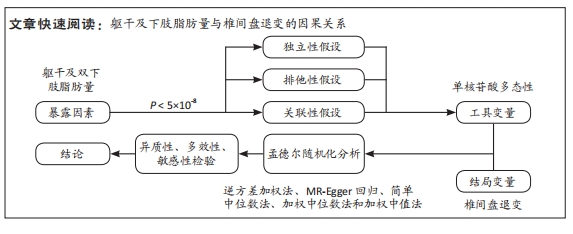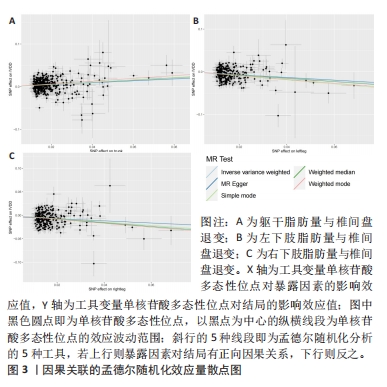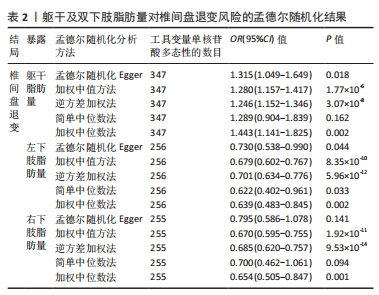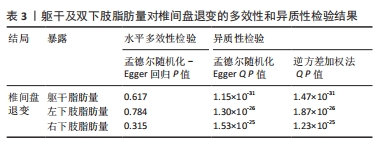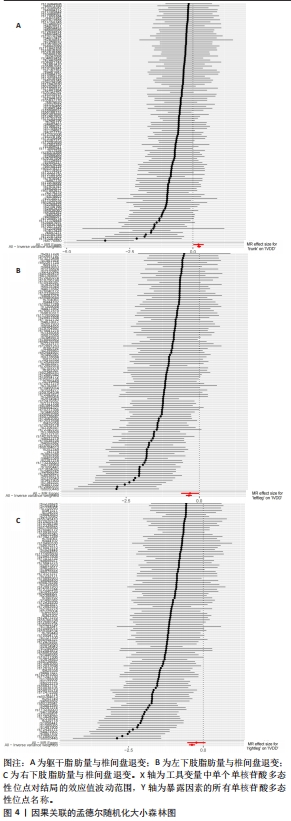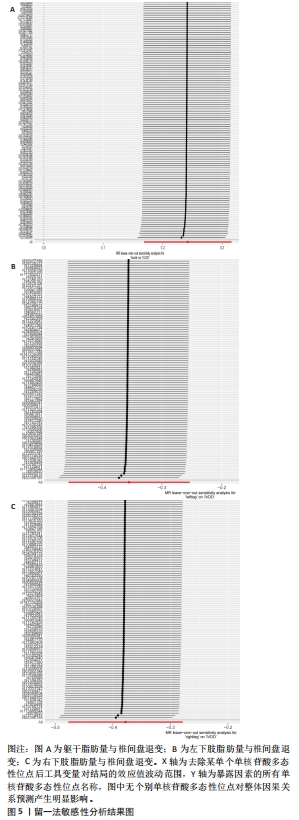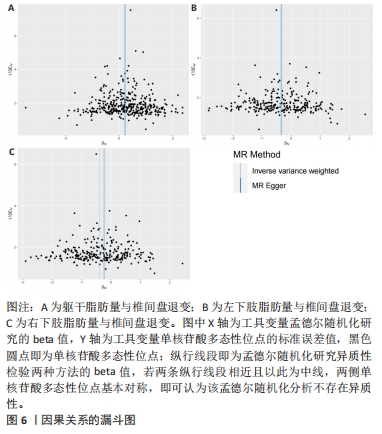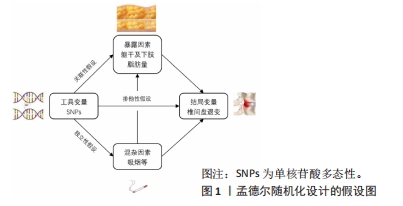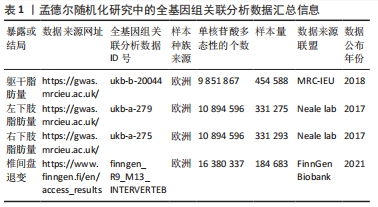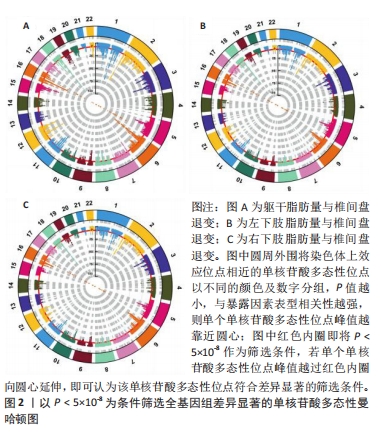[1] ZHENG CJ, CHEN J. Disc degeneration implies low back pain. Theor Biol Med Model. 2015;12:24.
[2] DAMMERS R, KOEHLER PJ. Lumbar disc herniation: level increases with age. Surg Neurol. 2002;58(3-4):209-212; discussion 212-213.
[3] HECHAVARRIA ME, RICHARD SA. Elucidating the focal immunomodulatory clues influencing mesenchymal stem cells in the milieu of intervertebral disc degeneration. Curr Stem Cell Res Ther. 2023;18(1):62-75.
[4] TREFILOVA VV, SHNAYDER NA, PETROVA MM, et al. The role of polymorphisms in collagen-encoding genes in intervertebral disc degeneration. Biomolecules. 2021;11(9):1279.
[5] KIRNAZ S, CAPADONA C, WONG T, et al. Fundamentals of intervertebral disc degeneration. World Neurosurg. 2022;157:264-273.
[6] 徐波,黄泽灵,张龙,等.中国人群腰椎间盘突出症患病率的Meta分析[J].中医正骨,2023,35(9):17-23.
[7] ZHAO CQ, LIU D, LI H, et al. Expression of leptin and its functional receptor on disc cells: contribution to cell proliferation. Spine (Phila Pa 1976). 2008;33(23):E858-E864.
[8] GO O, FREEEMAN RH, REAMS GP, et al. Obesity hypertension: pathophysiological role of leptin in neuroendocrine dysregulation. Am J Med Sci. 2014;347(6):485-489.
[9] DOWDELL J, ERWIN M, CHOMA T, et al. Intervertebral disk degeneration and repair. Neurosurgery. 2017;80(3S):S46-S54.
[10] BERIKOL G, EKŞI MŞ, AYDIN L, et al. Subcutaneous fat index: a reliable tool for lumbar spine studies. Eur Radiol. 2022;32(9):6504-6513.
[11] WANG M, YUAN H, LEI F, et al. Abdominal fat is a reliable indicator of lumbar intervertebral disc degeneration than BMI. World Neurosurg. 2023:S1878-8750(23)01630-016333.
[12] BURGESS S, DAVEY SMITH G, DAVIES NM, et al. Guidelines for performing Mendelian randomization investigations: update for summer 2023. Wellcome Open Res. 2023;4:186.
[13] NAZARZADEH M, PINHO-GOMES AC, BIDEL Z, et al. Plasma lipids and risk of aortic valve stenosis: a Mendelian randomization study. Eur Heart J. 2020;41(40):3913-3920.
[14] LAWLOR DA, HARBORD RM, STERNE JA, et al. Mendelian randomization: using genes as instruments for making causal inferences in epidemiology. Stat Med. 2008;27(8):1133-1163.
[15] CLARKE SLN, MITCHELL RE, SHARP GC, et al. Vitamin D levels and risk of juvenile idiopathic arthritis: a mendelian randomization study. Arthritis Care Res (Hoboken). 2023;75(3):674-681.
[16] ZHOU J, MI J, PENG Y, et al. Causal associations of obesity with the intervertebral degeneration, low back pain, and sciatica: a two-sample mendelian randomization study. Front Endocrinol (Lausanne). 2021;12: 740200.
[17] SKRIVANKOVA VW, RICHMOND RC, WOOLF BAR, et al. Strengthening the reporting of observational studies in epidemiology using mendelian randomization: the STROBE-MR statement. JAMA. 2021;326(16):
1614-1621.
[18] QIU S, ZHENG K, HU Y, et al. Genetic correlation, causal relationship, and shared loci between vitamin D and COVID-19: a genome-wide cross-trait analysis. J Med Virol. 2023;95(5):e28780.
[19] ZHOU T, SUN D, LI X, et al. Educational attainment and drinking behaviors: Mendelian randomization study in UK Biobank. Mol Psychiatry. 2021;26(8):4355-4366.
[20] 黄国鑫,陈霞丽,裴斌.孟德尔随机化探索骨密度与膝关节骨性关节炎的因果关联[J].中国骨质疏松杂志,2023,29(4):512-517.
[21] CODD V, NELSON CP, ALBRECHT E, et al. Identification of seven loci affecting mean telomere length and their association with disease. Nat Genet. 2013;45(4):422-427.
[22] LI W, LU Q, QIAN J, et al. Assessing the causal relationship between genetically determined inflammatory biomarkers and low back pain risk: a bidirectional two-sample Mendelian randomization study. Front Immunol. 2023;14:1174656.
[23] LEVIN MG, JUDY R, GILL D, et al. Genetics of height and risk of atrial fibrillation: a Mendelian randomization study. PLoS Med. 2020;17(10): e1003288.
[24] VERMEULEN JM, WOOTTON RE, TREUR JL, et al. Smoking and the risk for bipolar disorder: evidence from a bidirectional Mendelian randomisation study. Br J Psychiatry. 2021;218(2):88-94.
[25] ROSOFF DB, CLARKE TK, ADAMS MJ, et al. Educational attainment impacts drinking behaviors and risk for alcohol dependence: results from a two-sample Mendelian randomization study with ~780,000 participants. Mol Psychiatry. 2021;26(4):1119-1132.
[26] VERBANCK M, Chen CY, NEALE B, et al. Publisher Correction: detection of widespread horizontal pleiotropy in causal relationships inferred from Mendelian randomization between complex traits and diseases. Nat Genet. 2018;50(8):1196.
[27] BOWDEN J, DAVEY SMITH G, BURGESS S. Mendelian randomization with invalid instruments: effect estimation and bias detection through Egger regression. Int J Epidemiol. 2015;44(2):512-525.
[28] BURGESS S, DUDBRIDGE F, THOMPSON SG. Combining information on multiple instrumental variables in Mendelian randomization: comparison of allele score and summarized data methods. Stat Med. 2016;35(11): 1880-1906.
[29] BOWDEN J, DAVEY SMITH G, HAYCOCK PC, et al. Consistent estimation in mendelian randomization with some invalid instruments using a weighted median estimator. Genet Epidemiol. 2016;40(4):304-314.
[30] LU Y, WANG Z, ZHENG L. Association of smoking with coronary artery disease and myocardial infarction: a Mendelian randomization study. Eur J Prev Cardiol. 2021;28(12):e11-e12.
[31] ZHAO J, WANG J, XU H, et al. Intervertebral disk degeneration and bone mineral density: a bidirectional mendelian randomization study. Calcif Tissue Int. 2023. doi: 10.1007/s00223-023-01165-1.
[32] YUAN S, MIAO Y, RUAN X, et al. Therapeutic role of interleukin-1 receptor antagonist in pancreatic diseases: mendelian randomization study. Front Immunol. 2023;14:1240754.
[33] HAN Y, ZHANG Y, ZENG X. Assessment of causal associations between uric acid and 25-hydroxyvitamin D levels. Front Endocrinol (Lausanne). 2022; 13:1024675.
[34] LI J, BAI H, QIAO H, et al. Causal effects of COVID-19 on cancer risk: a Mendelian randomization study. J Med Virol. 2023;95(4):e28722.
[35] BENN M, MAROTT SCW, NORDESTGAARD BG. Obesity increases heart failure incidence and mortality: observational and Mendelian randomization studies totalling over 1 million individuals. Cardiovasc Res. 2023;118(18):3576-3585.
[36] DOBRIJEVIC E, VAN ZWIETEN A, KIRYLUK K, et al. Mendelian randomization for nephrologists. Kidney Int. 2023;104(6):1113-1123.
[37] 董杰,谭志宏,伍艳阳.肥胖与腰椎间盘退行性疾病及退变程度的关系研究[J].深圳中西医结合杂志,2021,31(15):32-34.
[38] JUNG M, ROSPLESZCZ S, LöFFLER MT, et al. Association of lumbar vertebral bone marrow and paraspinal muscle fat composition with intervertebral disc degeneration: 3T quantitative MRI findings from the population-based KORA study. Eur Radiol. 2023;33(3):1501-1512.
[39] KALB S, MARTIROSYAN NL, KALANI MY, et al. Genetics of the degenerated intervertebral disc. World Neurosurg. 2012;77(3-4):491-501.
[40] GUO W, LI BL, ZHAO JY, et al. Causal associations between modifiable risk factors and intervertebral disc degeneration. Spine J. 2023. doi: 10.1016/j.spinee.2023.10.021.
[41] WU Z, YANG Y, QIU G. Association study between the polymorphisms of the fat mass- and obesity-associated gene with the risk of intervertebral disc degeneration in the Han Chinese population. Genet Test Mol Biomarkers. 2013;17(10):756-762.
[42] SNIJDER MB, DEKKER JM, VISSER M, et al. Trunk fat and leg fat have independent and opposite associations with fasting and postload glucose levels: the Hoorn study. Diabetes Care. 2004;27(2):372-377.
[43] SEFAN N. Causes, consequences, and treatment of metabolically unhealthy fat distribution. Lancet Diabetes Endocrinol. 2020;8(7):616-627.
[44] GOOSSENS GH. The metabolic phenotype in obesity: fat mass, body fat distribution, and adipose tissue function. Obes Facts. 2017;10(3):207-215.
[45] YUKSEL Y, ERGUN T, TORUN E. Relationship between cervical posterior subcutaneous fat tissue thickness and the presence and degree of cervical intervertebral disc degeneration. Medicine (Baltimore). 2022; 101(28): e29890.
[46] RUIZ-FERNÁNDEZ C, FRANCISCO V, PINO J, et al. Molecular relationships among obesity, inflammation and intervertebral disc degeneration: are adipokines the common link? Int J Mol Sci. 2019;20(8):2030.
[47] OPIE LH, WALFISH PG. Plasma free fatty acid concentrations in obesity. N Engl J Med. 1963;268:757-760.
[48] SANDELL LJ. Etiology of osteoarthritis: genetics and synovial joint development. Nat Rev Rheumatol. 2012;8(2):77-89.
[49] DA CRUZ FERNANDES IM, PINTO RZ, FERREIRA P, et al. Low back pain, obesity, and inflammatory markers: exercise as potential treatment. J Exerc Rehabil. 2018;14(2):168-174.
[50] FRANCISCO V, PINO J, GONZÁLEZ-GAY MÁ, et al. A new immunometabolic perspective of intervertebral disc degeneration. Nat Rev Rheumatol. 2022;18(1):47-60.
[51] JAMALUDDIN MS, WEAKLEY SM, YAO Q, et al. Resistin: functional roles and therapeutic considerations for cardiovascular disease. Br J Pharmacol. 2012;165(3):622-632.
[52] LIU C, YANG H, GAO F, et al. Resistin promotes intervertebral disc degeneration by upregulation of ADAMTS-5 through p38 MAPK signaling pathway. Spine (Phila Pa 1976). 2016;41(18):1414-1420.
[53] 王成伟.腰椎椎旁肌横截面积和多裂肌脂肪浸润及不对称性对退行性腰椎滑脱的影响[J].感染、炎症、修复,2020,21(3):177-181.
[54] KUAI S, LIAO Z, ZHOU W, et al. The effect of lumbar disc herniation on musculoskeletal loadings in the spinal region during level walking and stair climbing. Med Sci Monit. 2017;23:3869-3877.
[55] VERGROESEN PP, KINGMA I, EMANUEl KS, et al. Mechanics and biology in intervertebral disc degeneration: a vicious circle. Osteoarthritis Cartilage. 2015;23(7):1057-1070.
[56] WEI J, HETTINGHOUSE A, Liu C. The role of progranulin in arthritis. Ann N Y Acad Sci. 2016;1383(1):5-20.
[57] WANG S, WEI J, FAN Y, et al. Progranulin is positively associated with intervertebral disc degeneration by interaction with IL-10 and IL-17 through TNF pathways. Inflammation. 2018;41(5):1852-1863.
[58] LI W, WU X, QU R, et al. Ghrelin protects against nucleus pulposus degeneration through inhibition of NF-κB signaling pathway and activation of Akt signaling pathway. Oncotarget. 2017;8(54):91887-91901.
[59] STEVENS J, KATZ EG, HUXLEY RR. Associations between gender, age and waist circumference. Eur J Clin Nutr. 2010;64(1):6-15.
[60] 武瑞骐,张璇,周毅,等.两样本孟德尔随机化分析他汀类药物与骨关节炎风险的关系[J].中国组织工程研究,2024,28(26):4106-4112. |
